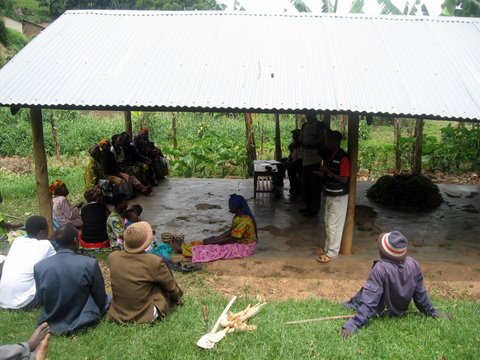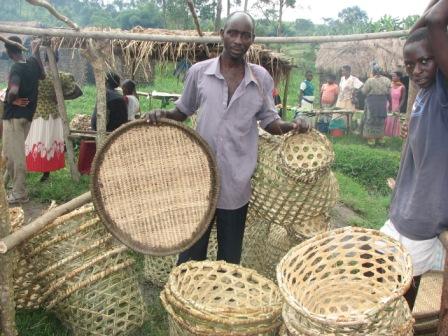|
When Bwindi was gazetted a national park in 1991, local people were no
longer allowed to enter the forest to extract any products, as they used
to when it was still a Forest Reserve. This led to resentment from the
communities towards the management authority (then the Uganda National
Parks) as they perceived it as a denial to resources important to their
livelihoods. In 1993, as a way of improving relations between the
parties, the Multiple Use (MU) program was introduced in some parts of
the park to allow for sustainable extraction of specific forest
non-timber products like crafts materials, medicinal plants and honey.
 The
aim of this study was to find out, after 10 years of the MU program,
which products local people have actually been extracting from the park,
how this helped them economically, socially and culturally. Had the
program indeed improved people’s perspectives on the park management?
Data was gathered by conducting interviews and using pre-designed
questionnaires in four parishes surrounding BINP, two with (72
respondents) and two without (25) MU agreements. These were; Mukono,
Bushura, Karangala and Rutugunda. Information was also gathered from key
informants who included local council chair persons and park Photo by
Munyuli
staff, in addition to direct observations The
aim of this study was to find out, after 10 years of the MU program,
which products local people have actually been extracting from the park,
how this helped them economically, socially and culturally. Had the
program indeed improved people’s perspectives on the park management?
Data was gathered by conducting interviews and using pre-designed
questionnaires in four parishes surrounding BINP, two with (72
respondents) and two without (25) MU agreements. These were; Mukono,
Bushura, Karangala and Rutugunda. Information was also gathered from key
informants who included local council chair persons and park Photo by
Munyuli
staff, in addition to direct observations
Most people (86%) had harvested forest products required for handicrafts
and basketry, the remaining 14% collected medicinal plants from the MU
zones. 4% of the people interviewed regarded the sale of handicrafts as
their primary source of income and considered the MU program to have
greatly contributed to their social wellbeing.
 Although
the program was created to improve relations between the park management
and local communities, the latter had little say in how it was
implemented. The location and size of the MU zones, as well as the rules
and regulations on harvesting were imposed by the park management on the
people. There are only a few people who harvest forest resources and
rules about harvesting are unclear to the majority of people. The author
concludes that the MU program was not participatory and had not
satisfactorily improved relations between local communities and the park
management.
Photo by R. Bitariho Although
the program was created to improve relations between the park management
and local communities, the latter had little say in how it was
implemented. The location and size of the MU zones, as well as the rules
and regulations on harvesting were imposed by the park management on the
people. There are only a few people who harvest forest resources and
rules about harvesting are unclear to the majority of people. The author
concludes that the MU program was not participatory and had not
satisfactorily improved relations between local communities and the park
management.
Photo by R. Bitariho
The author recommends that local communities should be more involved in
planning and decision making concerning the management of the park. If
park management wants to further improve relations with local
communities, it should assist them with introducing unpalatable crops
like coffee and tea to fend off crop raiding animals, and more often
consider local people to be employed in their social/community work.
|


 The
aim of this study was to find out, after 10 years of the MU program,
which products local people have actually been extracting from the park,
how this helped them economically, socially and culturally. Had the
program indeed improved people’s perspectives on the park management?
Data was gathered by conducting interviews and using pre-designed
questionnaires in four parishes surrounding BINP, two with (72
respondents) and two without (25) MU agreements. These were; Mukono,
Bushura, Karangala and Rutugunda. Information was also gathered from key
informants who included local council chair persons and park Photo by
Munyuli
staff, in addition to direct observations
The
aim of this study was to find out, after 10 years of the MU program,
which products local people have actually been extracting from the park,
how this helped them economically, socially and culturally. Had the
program indeed improved people’s perspectives on the park management?
Data was gathered by conducting interviews and using pre-designed
questionnaires in four parishes surrounding BINP, two with (72
respondents) and two without (25) MU agreements. These were; Mukono,
Bushura, Karangala and Rutugunda. Information was also gathered from key
informants who included local council chair persons and park Photo by
Munyuli
staff, in addition to direct observations Although
the program was created to improve relations between the park management
and local communities, the latter had little say in how it was
implemented. The location and size of the MU zones, as well as the rules
and regulations on harvesting were imposed by the park management on the
people. There are only a few people who harvest forest resources and
rules about harvesting are unclear to the majority of people. The author
concludes that the MU program was not participatory and had not
satisfactorily improved relations between local communities and the park
management.
Photo by R. Bitariho
Although
the program was created to improve relations between the park management
and local communities, the latter had little say in how it was
implemented. The location and size of the MU zones, as well as the rules
and regulations on harvesting were imposed by the park management on the
people. There are only a few people who harvest forest resources and
rules about harvesting are unclear to the majority of people. The author
concludes that the MU program was not participatory and had not
satisfactorily improved relations between local communities and the park
management.
Photo by R. Bitariho